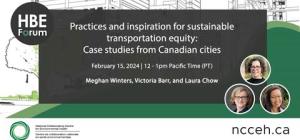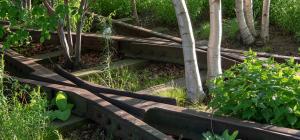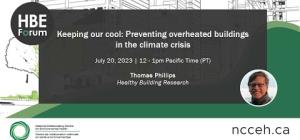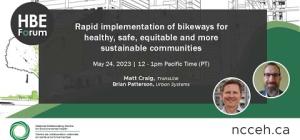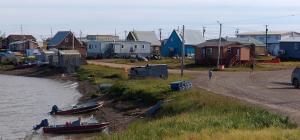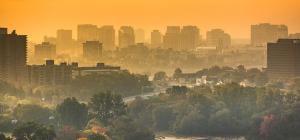
COVID-19 and outdoor safety: Considerations for use of outdoor recreational spaces
Introduction
Outdoor recreational spaces make important contributions to social well-being as well as physical and mental health. During a public health emergency such as the COVID-19 pandemic, the use of these spaces by large numbers of people may also increase the risk of community spread. Public health strategies to minimize disease transmission risk in outdoor spaces have focused on individual actions as well as community-based approaches. Key individual actions include quarantine if one has symptoms of COVID-19, or (for asymptomatic people) staying at least 2 metres (m) away from others, observing hand hygiene and respiratory etiquette (e.g., coughing or sneezing into a tissue, mask or elbow).1 In contrast, community-based approaches to COVID-19 management of outdoor spaces in Canada have involved precautionary closures and limits on activities and access.
However, closure of parks, amenities, and green spaces also restrict opportunities for healthy outdoor activity and stress relief, and may drive individuals to access less suitable and more congested spaces. Thus, the management of outdoor recreational spaces requires a thoughtful analysis to balance the needs of the population against the potential risks of community spread.
This document was developed to address concerns related to the safe use of public spaces during the COVID-19 outbreak. The available evidence is synthesized in order to increase the understanding of the types of community-based precautions available and options for implementing them.
Challenges associated with park closures due to COVID-19
There are a number of reasons why closing parks and green spaces may be highly undesirable. These challenges include the mental health impacts of the pandemic, the overall health benefits of access to green space, the potential for riskier alternatives, and health inequities created by closing public spaces.
Mental health impacts and the benefits of green spaces
The impact of the pandemic on mental health is expected to be severe. There are already numerous media reports of surges in the use of crisis hotlines,2 and new centres have been established across the country to deal with the anticipated high volumes of calls. Many agencies have added recommendations for dealing with COVID-19-related stress. For example, the Canadian Association for Mental Health has a dedicated webpage with information and advice to help people deal with quarantine and self-isolation; supporting children, family and friends; and stigma and prejudice related to the pandemic.3
Access to outdoor green space is a demonstrated public health asset. Spending time in outdoor spaces is important for avoiding social isolation and engaging in physical activities, outdoor play or simply enjoying a change of scenery and fresh air.4,5 Due to restrictions on gatherings, movement, and related closures of workplaces and indoor recreational spaces, the pandemic has further amplified the overall contribution of outdoor public spaces to physical and mental health. It is therefore unsurprising that park use is increasing especially when weather is fair. Metro Vancouver reported higher than average use in 60% of its parks in the two weeks following the implementation of physical distancing measures.6 With many people unable to work and milder weather approaching, it is reasonable to assume that demand for outdoor recreational space will continue to rise.
Creating drivers for risky behavior
In a time of extraordinary stress related to the uncertain health and financial well-being of self and family, removing a potential resource for stress relief creates its own health challenges and may drive other negative behaviors. If parks and squares are inaccessible, people may move to other less desirable options, such as sidewalks and pavements that are not designed to encourage physical distancing when occupancy is high.7 More people crowding onto these high-traffic zones will inevitably result in failure to maintain a 2-m distance. Research on influenza outbreaks has suggested that crowding, even in an outdoor environment, may make a difference in the occurrence of an outbreak.8 Thus, allowing and enabling people to spread out as much as possible in outdoor spaces will reduce the risk of disease transmission.
Contribution of park closures to health inequities
Park closures are a health equity issue. Unlike higher-income families living in detached housing, those living in multi-unit residential buildings in urban centres often do not have access to private green space.9 Closing public green spaces amplifies a number of pandemic-driven stressors (income loss, food insecurity, health comorbidities) that will disproportionately impact the ability of these families and individuals to weather the emergency. Thus, the management of green spaces, like all other aspects of the COVID-19 pandemic, requires a health equity lens.10
Potential factors that impact the transmission of SARS-CoV-2 in outdoor environments
Maintaining safe access to green spaces is a challenge given that our knowledge of disease transmission is evolving rapidly. Most SARS-CoV-2 studies pertain to indoor environments, primarily from hospital and homecare settings and, in a few notable cases, cruise ships. At the time of writing, there is very limited research regarding SARS-CoV-2 in outdoor environments. However, SARS-CoV-2 studies in healthcare and laboratory settings and previous research on other respiratory outbreaks can be used to frame some key questions about the risks of SARS-CoV-2 transmission in outdoor spaces.
How is SARS-CoV-2 transmitted and what routes are relevant for outdoor spaces?
The primary modes of SARS-CoV-2 transmission are direct contact with an infected person or their respiratory droplets.11 Respiratory droplets are generated by talking, breathing, coughing, and sneezing, and are thought to travel less than 1 m before dropping to the ground.12 For this reason, maintaining a 2-m radius (i.e., double the “fall out” zone) is central to strategies for limiting the spread of the COVID-19 disease.11,13 Because maintaining a 2-m radius is logically easier in outdoor spaces, we would expect a reduced risk of transmission in uncrowded outdoor spaces compared to indoor spaces.
Contact with contaminated surfaces (hand to the eyes, mouth, or nose) is another recognized mode of SARS-CoV-2 transmission,11,14 and one that is not affected by the 2-m physical distancing rule. Surfaces become contaminated when respiratory droplets settle upon them. Transmission risk then depends on several factors, including the concentration of viable virus deposited and its viability on a specific surface for a given time period. In a recent laboratory study, SARS-CoV-2 was still detectable (but greatly reduced) on polypropylene plastic at 72 h, on stainless steel at 48 h, on cardboard at 24 h, and on copper at 4 h.15 This is consistent with Chin et al.,16 who found that the virus remained viable and detectable on plastic and steel for four days, on glass for two days, and on wood for one day (all at 22oC). The virus persisted much longer on smooth, nonporous surfaces compared to porous surfaces (wood, paper, cloth). Surfaces were not analyzed at different temperatures, but when suspended in culture fluid, the virus remained detectable for twice as long at 4°C than at 22°C. This may be a concern for viral persistence on outdoor surfaces in cooler weather, although more data is required.
There is some evidence that the SARS-CoV-2 virus is shed via the feces17 and the virus has been detected in the toilets of ill people.18,19 In one study that collected air samples throughout a busy hospital environment, the highest virus levels were found in the air in a “mobile toilet”.20 This was attributed to people coughing or sneezing in an enclosed space, as well as the potential for aerosolization of the virus from flushing. “Toilet plumes” have been previously discussed as a means for disease transmission.21 Although there is insufficient evidence to determine whether this pathway is significant in the current pandemic, fecal transmission may be a consideration for the management of public washrooms.
Aerosol transmission: a key concern for park users
One of the key concerns for park users is whether COVID-19 can be transmitted via the exhalations of other users. Coughing, sneezing, talking and even breathing all produce aerosols that range in size from the larger respiratory droplets (> 5 μm), which settle quickly, to very fine droplets or particles (< 5 μm) that can remain suspended in the air for longer, travel greater distances, and can be inhaled deeply into the lungs.22 Aerosol transmission in this manner raises concerns that the 2-m “safe distance” may not be adequately protective, given research demonstrating that human sneezes can propel aerosols up to 8 m from an infected person.23 Recent modelling data (from an unpublished, non-peer-reviewed source) suggests that turbulence created by biking, running, and walking can entrain droplets, causing them to remain suspended longer and thus also increasing the safe radius.24 However, the risk of disease transmission depends not only on the generation of virus-containing aerosols, but also on the ability of the aerosolized virus to remain sufficiently concentrated and infectious by the time it reaches the next host.
Although the existing research on SARS-CoV-2 does support the generation of aerosols containing the virus, it does not yet support the virus remaining suspended or remaining infectious in suspension. Viral RNA has been detected in the air in hospital rooms and corridors, in the presence of sick patients, and even outdoors,19,20 although not in all cases.18 Viral RNA has also been found widely dispersed in the environment around an infected person, even on surfaces that the patient could not have touched or was distant from.18,19,25 These studies suggest that virus moved around the environment, perhaps as an aerosol, but does not indicate how long the virus remained viable and/or suspended. In the laboratory, a highly concentrated virus aerosol remained infectious for 3 h.15 In contrast, in a healthcare setting, virus recovered in air samples from patient rooms and corridors was not able to reinfect cultured cells.19 This indicates that either the aerosolized virus was no longer viable or that the amounts recovered were too low to cause infection. Thus, a great deal of additional information is required to understand whether COVID-19 can be transmitted via aerosols, particularly outdoors where virus-containing aerosols can be rapidly dispersed.
However, we do have reason to believe that aerosol transmission, if it is occurring, is not a primary mode of transmission in this pandemic. Research looking at healthcare workers, travellers on air planes, and the household contacts of tens of thousands of COVID-19 cases has consistently shown that transmission is strongly dependent on being in close proximity to a sick person for some period of time.26 This is in stark contrast to some well-known airborne diseases, like measles, in which the generation of a long-lived aerosol allows transmission even if the person has never been in the presence of an infected case. For this reason, the World Health Organization does not currently consider airborne transmission to be a primary mode of transmission for the general public.11 In Canada, healthcare workers who are performing procedures that artificially generate large amounts of aerosols (e.g., intubating a patient) are asked to use “airborne precautions.” However, all other patient care is conducted under droplet and contact precautions only.27
Although virus particles may be detected in the air, physical distancing protects park users from the primary modes of transmission: direct contact and respiratory droplet transmission. However, hand hygiene and respiratory etiquette are also necessary to protect park users from SARS-CoV-2 that has been deposited on surfaces. Airborne precautions for the general public are not recommended by the Public Health Agency of Canada at this time, although it is acknowledged that wearing a non-medical face mask may be helpful if it serves to limit virus emitted by sick people who may or may not be symptomatic.28
How might the SARS-CoV-2 virus be affected by outdoor environmental factors?
A number of factors could influence the presence and viability of SARS-CoV-2 in outdoor spaces. Because there is insufficient evidence to assess the risk of transmission in outdoor environments, precautions must be based on what is known about SARS-CoV-2 in indoor and laboratory environments and other pathogens in outdoor environments. These factors include:
- Crowding. Previous research on mass gatherings has suggested that holding events in uncrowded outdoor venues was the least likely to result in influenza outbreaks.8
- Wind speed and direction. Particles settle more quickly in disturbed air because they are more likely to be intercepted by surfaces.12 However, in highly turbulent air particles may also remain suspended longer.
- Meteorological conditions (temperature, humidity, and UV). There is some evidence that SARS-Cov2 transmission may be affected by changes in temperature and humidity,29,30 which may affect the viability of the virus on surfaces and in droplets, but also independently modulate host immunity/susceptibility.31 It is also thought that UV radiation from sunlight affects the viability of influenza virus suspended in aerosols,32 such that changes in UV index may influence influenza transmission and the seasonality of outbreaks.33 Overall, however, the effects of meteorological conditions are expected to be quite small, as the current determining factor in transmission is the number of vulnerable hosts and the contact between them.31
Actions taken in other jurisdictions
There are currently several different approaches being taken to manage outdoor recreational spaces in Canada and elsewhere, and these have different implications at the federal/provincial versus municipal levels. At the federal level, all motor vehicle access to national parks, historic sites, and marine conservation areas was suspended on March 25, 2020. At the time of writing, the majority of provincial parks and recreational areas are also closed. This is intended to reduce non-essential staffing at park sites and minimize the risk of wildfires or the need for search and rescue.34 However, it also serves the key purpose of discouraging non-essential travel or pandemic tourism by members of the public who would or should remain at home.35 Discouraging travel to distant parks also discourages incidental contacts with services and people along the route, which might otherwise bring the virus into smaller or remote communities
The decision to close parks in urban areas is more complex. Because urban provincial and national parks are closed, the available green space in or near many cities has been reduced. Parks controlled by municipalities therefore need to be managed thoughtfully to avoid some of the adverse impacts of lack of green space. Many Canadian cities have tried to address transmission risk by closing specific amenities that people touch or that cause people to interact, such as such as playgrounds, skateboard parks, courts, spray parks, picnic areas, shelters and gazebos, and outdoor exercise equipment.36-40 The province of Ontario’s emergency orders specify that areas not otherwise closed would be available for walk-through access only,41 and the City of Richmond has implemented one-way traffic on walking trails to minimize interaction.42 In some cases, enforcement officers have been deployed to maintain physical distancing in problem areas.43,44 In Vancouver, park “champions” dressed in colourful clothing and carrying props are being used to remind users of physical distancing, alongside park rangers issuing fines, as well as parking lot and road closures to discourage non-local users and increase distancing between cyclists and pedestrians.45 Full park closures remain an option if these partial measures do not have the desired effect.
However, not all jurisdictions are moving to close or limit recreational spaces. In some cities, the lack of road traffic has created opportunities to open streets as pedestrian thoroughfares, particularly when there are no parks or green spaces nearby.9,46 Opening new spaces encourages dispersion in the local environment, rather than resorting to non-essential travel or aggregating on sidewalks. This approach also addresses the fundamental inequity of access to green space for those living in multi-unit residential complexes. In London, park users have been asked to keep to local parks (to minimize travel) or better yet to remain in their own yard if they have one, in order to prioritize the use of public parks for those with no access to private green space.44 Given that the pandemic will require long-term changes to how people interact in public spaces, finding strategies that increase rather than decrease outdoor recreational opportunities is preferred.
Options for risk reduction in outdoor spaces
The evidence presented here informs a number of potential actions for reducing the risk of transmission. However, each recreational area must be assessed for transmission risks such that the appropriate combination of measures can be implemented.
- Maximize distance and minimize interaction between park users, particularly where narrow trails or passages may bring people closer together (e.g., unidirectional traffic on trail loops).
- Close or remove features that cause visitors to gather, such as viewpoints or seating. If such gathering points can’t be closed (e.g., entrances and exits to the park), provide limited supervision to those areas to encourage physical distancing.
- Close features on which virus may have settled, particularly those that have been in close contact with potentially ill people (e.g., playgrounds).
- Sanitizing surfaces may be necessary in specific situations, in which case priority should be given to smooth, non-porous surfaces on which the virus is most persistent.
- Discourage activities that involve physical contact, by closing sports fields and/or providing limited supervision to ensure distancing during activities.
- Washrooms may be a necessity. However, because of the presence of virus in feces and the potential for that virus to be aerosolized by toilets, public washrooms will require additional sanitation if they remain open. Users should be advised to close the toilet lid if possible. Ventilation of these spaces should be maximized.
- Provide opportunities for hand hygiene, particularly if washrooms have been closed. Vandalism-proof hand sanitizer or hand wash stations may be needed.
- Ensure that trash containers are available for discarding personal protective equipment (e.g., masks and gloves), which may otherwise become a public health hazard.
- Consider neighbourhood access to parks before moving to restrict already limited options. If many residents need to access the same space, weekly scheduling by home address may be an option. Park space can be limited to local residents by closing parking lots.
- Increase space available to encourage dispersion and non-collective activities. Additional spaces may include streets and parking lots closed to vehicles, as well as private green spaces in urban areas, such as golf courses and other sports fields. Update online park information to reflect these new options for dispersion.
- Increase enforcement of health orders regarding physical distancing measures through deployment of sufficient numbers of authorized personnel.
- Recommendations on the use of masks should refer to the Public Health Agency of Canada’s position on non-medical masks and disease transmission.28 At present, airborne transmission is not considered a primary mode of transmission; however, there are many other considerations around masks that may inform their use by the public, such as reducing risk from people who may be shedding the virus through coughing and sneezing.
Summary
The management of outdoor public spaces to limit the spread of the SARS-CoV-2 virus needs to be guided by updated evidence on the main routes of transmission as well as an understanding of the important beneficial role played by parks, green spaces, and other open areas in reducing stress and promoting health for people of all ages. Currently, direct physical contact and close proximity are regarded as the most important transmission risk factors and community-based measures are largely focused on physical distancing. The evidence on the risks of aerosol transmission and transmission from touching surfaces in outdoor environments is at this time weak, but research is ongoing and results could lead to changes in recommendations.
There are a number of uncertainties surrounding transmission of COVID-19 in outdoor environments that are relevant for public health decision-making:
- What is a “safe distance”? Although the majority of public health agencies recommend a 2-m radius, this safe distance may have to be amended if it proves that SARS-CoV-2 can be transmitted as an aerosol in a public setting. However, the current evidence strongly suggests that close proximity is a key factor in transmission.
- How effective are non-medical masks used by the public? There are many unanswered questions about the effectiveness of using cloth face coverings (e.g., masks, scarves, bandanas) in protecting against COVID-19.47 Although the US CDC has recently advised people to wear face coverings in public spaces,48 PHAC continues to emphasize that physical distancing, hand hygiene, and respiratory etiquette are the key means to slow transmission. Masks may be of use to prevent ill people from emitting virus, but mask use alone is insufficient to prevent healthy people from contracting the virus.28 However, much additional work is needed to understand how effective these home-made cloth barriers are when worn by either healthy or ill people.
- How long does the virus survive outdoors? All of the currently available studies on viruses in air, on surfaces, viability and disinfection are from experimental or clinical settings. Results for outdoor environments are not yet available but have been prioritized for research.49
Unlike many previous public health emergencies, the COVID-19 pandemic is likely to involve long-term cycles during which infection rates will rise and fall over several years. Policies and interventions will need to adapt and change through these cycles and societal systems will need to evolve to control future outbreaks.50 Public health decision-making concerning outdoor recreational spaces is part of this evolving system. The effectiveness of park closures will depend on how well they are coordinated with other prevention strategies, ongoing public education, and the engagement and mobilization of personnel and community groups in communication, monitoring, and enforcement.
Acknowledgements
This document benefited from the contributions of Michele Wiens, Juliette O’Keeffe, and Lydia Ma of the NCCEH.
References
1. Public Health Agency of Canada. Coronavirus disease (COVID-19): Prevention and risks. 2020. Available from https://www.canada.ca/en/public-health/services/diseases/2019-novel-coronavirus-infection/prevention-risks.html Accessed 04/07/2020. Ottawa, ON: PHAC; 2020 [updated 2020 Apr 11; cited 2020 Apr 4]; Available from: https://www.canada.ca/en/public-health/services/diseases/2019-novel-coronavirus-infection/prevention-risks.html.
2. Gilmour M, Kovac A. COVID-19 taking a toll on Quebecers' mental health: psychologists. CTV News Montreal. 2020 Mar 29. Available from: https://montreal.ctvnews.ca/covid-19-taking-a-toll-on-quebecers-mental-health-psychologists-1.4873609.
3. Canadian Association for Mental Health. Mental health and the COVID-19 pandemic. Toronto, ON: CAMH; 2020; Available from: https://www.camh.ca/en/health-info/mental-health-and-covid-19.
4. Wolf KL, Flora K. Mental health & function. Green cities: good health. Bothell, WA: University of Washington, College of the Environment; 2010. Available from: https://depts.washington.edu/hhwb/Thm_Mental.html.
5. Rugel E, Ward H. Green space and mental health: pathways, impacts, and gaps. Vancouver, BC: National Collaborating Centre for Environmental Health; 2015 Mar. Available from: http://www.ncceh.ca/documents/evidence-review/green-space-and-mental-health-pathways-impacts-and-gaps.
6. Godfrey D. No COVID-19-related park closures. BurnabyNow. 2020 Mar 26. Available from: https://www.burnabynow.com/news/no-covid-19-related-park-closures-expected-in-burnaby-1.24107029.
7. Barkhorn E. Rules for using the sidewalk during the coronavirus. New York Times. 2020 Apr 5. Available from: https://www.nytimes.com/2020/04/05/opinion/coronavirus-walk-outside.html?auth=login-google&referringSource=articleShare.
8. Public Health England. Impact of mass gatherings on an influenza pandemic - scientific evidence base review. London, UK: Commissioned by the Department of Health and produced by Public Health England; 2014 May. Available from: https://assets.publishing.service.gov.uk/government/uploads/system/uploads/attachment_data/file/316200/Mass_Gatherings_evidence_Review.pdf.
9. Walker A. In the coronavirus crisis, who gets to be outside? Los Angeles, CA: Vox Media; 2020 Mar 30. Available from: https://www.curbed.com/2020/3/27/21191714/coronavirus-public-spaces-parks-hiking-trails.
10. National Collaborating Centre for Determinants of Health. Equity-informed responses to COVID-19. Antigonish, NS: St. Francis Xavier University; 2020 Mar. Available from: http://nccdh.ca/our-work/covid-19?mc_cid=83b92dbc71&mc_eid=04816d6ac3.
11. World Health Organization. Modes of transmission of virus causing COVID-19: implications for IPC precaution recommendations. Scientific brief. Geneva, Switzerland: WHO; 2020 Mar 29. Available from: https://www.who.int/news-room/commentaries/detail/modes-of-transmission-of-virus-causing-covid-19-implications-for-ipc-precaution-recommendations.
12. Atkinson J, Chartier Y, Pessoa-Silva CL, Jensen P, Li Y, Seto WH, editors. Natural ventilation for infection control in health-care settings. Annex C. Respiratory droplets. Geneva, Switzerland: World Health Organization; 2009. Available from: https://www.ncbi.nlm.nih.gov/books/NBK143281/.
13. National Academies of Sciences Engineering and Medicine. Rapid expert consultation on social distancing for the COVID-19 pandemic. Washington, DC: The National Academies Press; 2020 Mar 19. Available from: https://www.nap.edu/read/25753/chapter/1.
14. Public Health Agency of Canada. Physical distancing (fact sheet). Ottawa, ON: PHAC; 2020 [updated 2020 Apr 9; cited 2020 Apr 11]; Available from: https://www.canada.ca/en/public-health/services/publications/diseases-conditions/social-distancing.html.
15. van Doremalen N, Bushmaker T, Morris DH, Holbrook MG, Gamble A, Williamson BN, et al. Aerosol and surface stability of SARS-CoV-2 as Compared with SARS-CoV-1. N Engl J Med. 2020. Available from: https://doi.org/10.1056/NEJMc2004973.
16. Chin AWH, Chu JTS, Perera MRA, Hui KPY, Yen H-L, Chan MCW, et al. Stability of SARS-CoV-2 in different environmental conditions. The Lancet Microbe. 2020 Apr 2. Available from: https://doi.org/10.1016/S2666-5247(20)30003-3.
17. Xiao F, Tang M, Zheng X, Liu Y, Li X, Shan H. Evidence for gastrointestinal infection of SARS-CoV-2. Gastroenterology. 2020 Mar 29. Available from: https://doi.org/10.1053/j.gastro.2020.02.055.
18. Ong SWX, Tan YK, Chia PY, Lee TH, Ng OT, Wong MSY, et al. Air, surface environmental, and personal protective equipment contamination by severe acute respiratory syndrome coronavirus 2 (SARS-CoV-2) from a symptomatic patient. JAMA. 2020 Mar 4. Available from: https://doi.org/10.1001/jama.2020.3227.
19. Santarpia JL, Rivera DN, Herrera V, Morwitzer MJ, Creager H, Santarpia GW, et al. Transmission potential of SARS-CoV-2 in viral shedding observed at the University of Nebraska Medical Center. medRxiv. 2020 Mar 26. Available from: http://medrxiv.org/content/early/2020/03/26/2020.03.23.20039446.1.abstract.
20. Liu Y, Ning Z, Chen Y, Guo M, Liu Y, Gali NK, et al. Aerodynamic characteristics and RNA concentration of SARS-CoV-2 aerosol in wuhan hospitals during COVID-19 outbreak. bioRxiv. 2020 Mar 8. Available from: http://biorxiv.org/content/early/2020/03/10/2020.03.08.982637.abstract.
21. Johnson DL, Mead KR, Lynch RA, Hirst DVL. Lifting the lid on toilet plume aerosol: a literature review with suggestions for future research. Am J Infect Control. 2013;41(3):254-8. Available from: http://www.sciencedirect.com/science/article/pii/S0196655312008127.
22. Shiu EYC, Leung NHL, Cowling BJ. Controversy around airborne versus droplet transmission of respiratory viruses: implication for infection prevention. Curr Opin Infect Dis. 2019;32(4):372-9. Available from: https://doi.org/10.1097/qco.0000000000000563.
23. Bourouiba L. Turbulent gas clouds and respiratory pathogen emissions: potential implications for reducing transmission of COVID-19. JAMA. 2020 Mar 26. Available from: https://doi.org/10.1001/jama.2020.4756.
24. Blocken B, Malizia F, van Druenen T, Marchal T. Social distancing v2.0: during walking, running and cycling. Eindhoven, Netherlands: Eindhoven University of Technology; 2020 Apr. Available from: https://media.real.gr/filesystem/Multimedia/pdf/Social_Distancing_v20_White_Paper_id38170.pdf.
25. Moriarty LF, Plucinski MM, Marston BJ, Kurbatova EV, Knust B, Murray EL, et al. Public health responses to COVID-19 outbreaks on cruise ships — worldwide, February–March 2020. MMWR Morb Mortal Wkly Rep. 2020;69(12):347-52. Available from: http://www.cdc.gov/mmwr/volumes/69/wr/mm6912e3.htm?s_cid=mm6912e3_w.
26. Ontario Agency for Health Protection Promotion. COVID-19 – What we know so far about… routes of transmission. Toronto, ON: OAHPP; 2020 Mar 6. Available from: https://www.publichealthontario.ca/-/media/documents/ncov/wwksf-routes-transmission-mar-06-2020.pdf?la=en.
27. Public Health Agency of Canada. Infection prevention and control for coronavirus disease (COVID-19): Interim guidance for acute healthcare settings. Ottawa, ON: PHAC; 2020 [updated 2020 Feb 24; cited 2020 Apr 4]; Available from: https://www.canada.ca/en/public-health/services/diseases/2019-novel-coronavirus-infection/health-professionals/interim-guidance-acute-healthcare-settings.html.
28. Public Health Agency of Canada. Coronavirus disease (COVID-19): prevention and risks. Ottawa, ON: PHAC; 2020 [updated 2020 Apr 4; cited 2020 Apr 4]; Available from: https://www.canada.ca/en/public-health/services/diseases/2019-novel-coronavirus-infection/prevention-risks.html.
29. Luo W, Majumder MS, Liu D, Poirier C, Mandl KD, Lipsitch M, et al. The role of absolute humidity on transmission rates of the COVID-19 outbreak. medRxiv. 2020 Feb 12. Available from: https://www.medrxiv.org/content/medrxiv/early/2020/02/17/2020.02.12.20022467.full.pdf.
30. Wang M, Jiang A, Gong L, Luo L, Guo W, Li C, et al. Temperature significant change COVID-19 Transmission in 429 cities. medRxiv. 2020 Feb 25. Available from: https://www.medrxiv.org/content/medrxiv/early/2020/02/25/2020.02.22.20025791.full.pdf.
31. Lipsitch M. Seasonality of SARS-CoV-2: will COVID-19 go away on its own in warmer weather? Boston, MA: Harvard T.H. Chan School of Public Health, Center for Communicable Disease Dynamics; 2020; Available from: https://ccdd.hsph.harvard.edu/will-covid-19-go-away-on-its-own-in-warmer-weather/.
32. Schuit M, Gardner S, Wood S, Bower K, Williams G, Freeburger D, et al. The influence of simulated sunlight on the inactivation of influenza virus in aerosols. J Infect Dis. 2019;221(3):372-8. Available from: https://doi.org/10.1093/infdis/jiz582.
33. Ianevski A, Zusinaite E, Shtaida N, Kallio-Kokko H, Valkonen M, Kantele A, et al. Low temperature and low UV indexes correlated with peaks of influenza virus activity in Northern Europe during 2010–2018. Viruses. 2019;11(3):207. Available from: https://www.mdpi.com/1999-4915/11/3/207.
34. Parks Canada. Temporary closure of Parks Canada places. Gatineau, QC: Parks Canada National Office; 2020 [updated 2020 Apr 2; cited 2020 Apr 4]; Available from: https://www.pc.gc.ca/en/voyage-travel/securite-safety/covid-19-info/covid-19-faq.
35. Kotyk A. All provincial parks in B.C. closed to stop spread of novel coronavirus. CTV News Vancouver. 2020 Apr 8. Available from: https://bc.ctvnews.ca/all-provincial-parks-in-b-c-closed-to-stop-spread-of-novel-coronavirus-1.4888064.
36. Boynton S. Metro Vancouver cities close outdoor sports areas as youth defy coronavirus measures. Global News. 2020 Mar 22. Available from: https://globalnews.ca/news/6714989/coronavirus-lower-mainland-sports-closure/.
37. City of Guelph. Guelph acting on Provincial order to close all recreation amenities to slow spread of COVID-19, get people to stay home. 2020 Mar 31. Available from: https://guelph.ca/2020/03/guelph-acting-on-provincial-order-to-close-all-recreation-amenities-to-slow-spread-of-covid-19-get-people-to-stay-home/.
38. City of Vancouver. Affected city and park facilities and services during the coronavirus (COVID-19) pandemic. Vancouver, BC: City of Vancouver; 2020 [cited 2020 Apr 4]; Available from: https://vancouver.ca/home-property-development/coronavirus-whats-closed-affected-or-still-open.aspx.
39. Desjardins S. Why the COVID-19 pandemic means being careful about public playgrounds. CBC Prince Edward Island. 2020 Mar 20. Available from: https://www.cbc.ca/news/canada/prince-edward-island/pei-playgrounds-covid-19-1.5504188.
40. Strathcona County. COVID-19 - Novel Coronavirus. Sherwood Park, AB: County of Strathcona; 2020 [updated 2020 Apr 9]; Available from: https://www.strathcona.ca/council-county/news/covid19/.
41. Government of Ontario. Ontario extends emergency declaration to stop the spread of COVID-19. 2020 Mar 30. Available from: https://news.ontario.ca/opo/en/2020/03/ontario-extends-emergency-declaration-to-stop-the-spread-of-covid-19.html.
42. Chan K. City of Richmond mandates one-way walking direction for popular park. DailyHive. 2020. Available from: https://dailyhive.com/vancouver/richmond-garry-point-park-walking-route.
43. City of Edmonton. COVID-19 (coronavirus), Park Operations. Edmonton, AB: City of Edmonton; 2020. Available from: https://www.edmonton.ca/activities_parks_recreation/parks_rivervalley/park-operations.aspx.
44. Greater London Authority. London parks and green spaces – COVID-19 guidance. London, UK: London Assembly, Mayor of London; 2020 [updated 2020 Apr 7; cited 2020 Apr 8]; Available from: https://www.london.gov.uk/coronavirus/london-parks-and-green-spaces-covid-19-guidance.
45. Vancouver Park Board. Vancouver Board of Parks and Recreation. Vancouver, BC: City of Vancouver; 2020; Available from: https://vancouver.ca/your-government/vancouver-board-of-parks-and-recreation.aspx.
46. Hawkins AJ. There’s no better time for cities to take space away from cars. New York, NY: The Verge; 2020 Mar 23.; Available from: https://www.theverge.com/2020/3/23/21191325/cities-car-free-coronavirus-protected-bike-lanes-air-quality-social-distancing.
47. Ontario Agency for Health Protection Promotion. 2019-nCoV – What we know so far about…wearing masks in public. Toronto, ON: OAHPP; 2020 Apr 7. Available from: https://www.publichealthontario.ca/-/media/documents/ncov/covid-wwksf/what-we-know-public-masks-apr-7-2020.pdf?la=en.
48. US Centers for Disease Control Prevention. How to protect yourself & others. Atlanta, GA: US Department of Health and Human Services; 2020 [updated 2020 Apr 13; cited 2020 Apr 13]; Available from: https://www.cdc.gov/coronavirus/2019-ncov/prevent-getting-sick/prevention.html.
49. National Academies of Sciences Engineering Medicine. Rapid expert consultation update on SARS-CoV-2 surface stability and incubation for the COVID-19 pandemic. Washington, DC: The National Academies Press; 2020 Mar 27. Available from: https://www.nap.edu/read/25763/chapter/1.
50. Bradley DT, Mansouri MA, Kee F, Garcia LMT. A systems approach to preventing and responding to COVID-19. EClinicalMedicine. 2020 Mar 28. Available from: https://doi.org/10.1016/j.eclinm.2020.100325.

